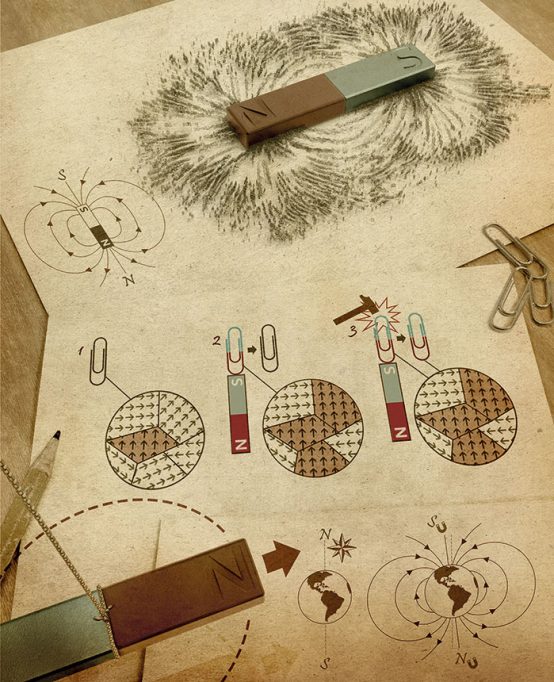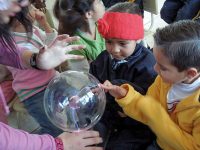
Years ago, an old man opened a magnet shop in front of my house. I bought a lot of very strong magnets, which I put in my pockets for safety. When I got on the bus, I sometimes felt a tug on my trousers that stopped me: it was not easy to separate pocket and magnet from the metal bar. As in the legend of Magnes the shepherd, quoted by Nicander and Pliny, whose boot nails and walking stick stuck to certain stones on Mount Ida (today’s Turkey). Magnetism was known to all civilisations, including several Mesoamerican ones. Perhaps millennia ago, a little girl played with magnetite stones for the first time, as I did when I was a child with my mother’s mysteriously magnetised sewing pins.
Take a bar magnet; one half is usually painted red (R) and the other blue (B). If we face different ends against each other (R-B, or B-R), they attract spontaneously and stick together. If we bring the same ends (R-R or B-B) closer together, a force, which is greater the closer they are, prevents them from coming closer. If one of the magnets is free, it will turn to join the other at the different end (therefore, the island of Laputa visited by Gulliver would not be able to float by magnetic repulsion). If we hang a magnet by a thread, it always aligns itself in the same direction, even if there is no other magnet nearby. This is a compass and responds to the Earth’s magnetism, as do migrating birds or some bacteria (where is their magnet located?).
The magnetic forces that we feel in our own hands are surprising, as are the lines that iron dust creates near a magnet, a visualisation of its sphere of influence – which we call a magnetic field. No wonder Thales attributed soul to the inert, no wonder magnetism has always been shrouded in a haze of esotericism. The worldwide hoax about alleged magnetic substances in the COVID-19 vaccine was accompanied by millions of videos and photos of the vaccinated, with spoons and keys attached to their arms. I can also stick spoons, even plastic ones, to various parts of my body: neither the vaccine nor magnetism have anything to do with it.
An iron object (a paper clip, a pin) is attracted to both poles of the magnet. When stuck to the magnet, the paperclip will attract another paperclip, and this one will attract yet another paperclip, like the chain mentioned by Socrates in Plato’s dialogue Ion. At the microscopic level, ferromagnetic objects are made up of magnetic domains. Each domain is dominated by a different magnetic direction, but because there are many of them, the overall magnetisation is zero. When the object is brought towards a magnet, those domains whose direction coincides with that of the magnet become larger and a net magnetisation appears, which disappears when the object is separated from the magnet. This magnetisation becomes permanent if we provide some energy: hitting or rubbing the object next to the magnet. This is how magnets were made in the past and how cassette tapes worked. And this is how ancient rocks became magnets, solidified in a geomagnetic field that was different from today’s. In the case of magnetite, a lightning strike perhaps millions of years ago provided the intense electric current to magnetise it. But we will leave this interesting story for another time.
The owner of the magnet shop, sporting a thin moustache from another era, typed out invoices on copy paper. Not without a certain condescension, I reflected on his rejection of computers. But he snapped me out of it: in a magnet shop, even at a distance, a hard drive’s days are numbered.
Try it:
You will need two magnets (you can buy them at a hardware store: ferrite, neodymium, etc.). Fridge magnets won’t do, as they do not usually have a defined polarity.
a) Bring two magnets together and check the situations mentioned in the text, whether they attract or repel each other.
b) Tie a thread in the centre of the magnet and observe which direction it faces when it hangs. Compare its orientation with that of a compass. Conventionally, the north pole (N) is the end that points towards geographic north and the south pole (S) points away from it. Therefore, our planet’s north pole is the magnetic south pole (and vice versa).
c) One magnet hangs from the thread. Bring the other one progressively closer so that the equal ends are facing each other (N-N or S-S): the dangling magnet (our compass) turns to offer the opposite pole. Now imagine: what would happen to the dangling magnet if the geomagnetic field suddenly reversed?





